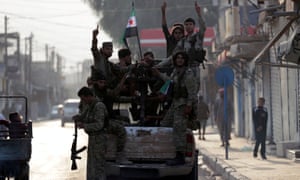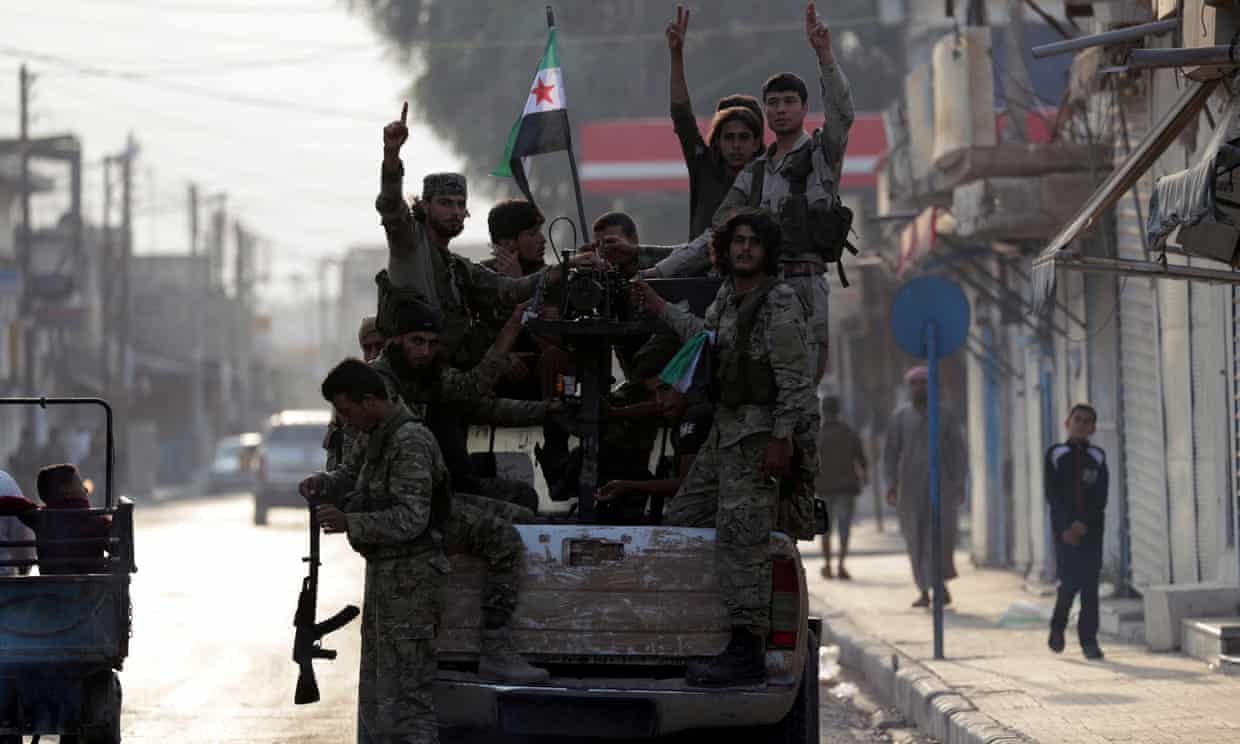Trump’s Turkey deal hands power to Ankara and leaves Syrian Kurds for dead
The deal agreed between the US and Turkey immediately achieved the priority objective of vice-president Mike Pence’s peace mission to Ankara: Donald Trump was able to claim victory on Twitter.
The president had unwittingly alienated most of his own party over his acceptance of the Turkish invasion of north-eastern Syria, and was already in the midst of an impeachment battle.
So when the talks were over in Ankara, the president’s thumbs were hovering over his phone and he turned the usual hyperbole up to maximum. “This is a great day for civilisation,” he exulted. “People have been trying to make this ‘Deal’ for many years. Millions of lives will be saved.”
The Turkish president, Recep Tayyip Erdoğan, also scored a quick win. The threat of US administration sanctions was suspended and his occupation of the Turkish-Syrian border zone was given an extra layer of respectability.
Otherwise it was hard to pinpoint what the 13-point document produced in Ankara actually meant. It was agreed between Turkey and the US, which has withdrawn its troops from the contested area.
Washington had been in touch with the actual combatants on the ground, the Kurdish-led Syrian Democratic Forces (SDF), but appears to have sold them a completely different deal.
The SDF commander, Mazloum Kobani, said he had agreed with the Americans that there would be a ceasefire in two areas about 100km apart, along the border where there was heavy fighting, Ras al-Ain, and Tal Abyad.
“As far as he is concerned the ceasefire is only where there’s active fighting and he totally rejects the idea of any kind of withdrawal, any removal of heavy weapons,” said Charles Lister, a Syria expert at the Middle East Institute. “So everyone seems to be talking a different language, which can only spell more trouble.”
The Ankara document envisages a 120-hour ceasefire in a “safe zone” that would be “primarily enforced by the Turkish armed forces”. The size of this “safe zone” is not defined. The phrase had been used to define a narrow strip of land along the border that was jointly patrolled by the Turks and US troops under an agreed joint security mechanism.
By invading, Erdogan had swept that mechanism aside, but in Ankara, Pence allowed the Turks to hijack the terms to refer to their area of occupation. Ankara said it would stretch 440 km from the Euphrates river to the Iraqi border, and 32km (20 miles) deep into Syria, up to the M4 highway which runs east-west across the region. The Turkish foreign minister said that across that whole area, Kurdish forces would have to hand over their heavy arms and withdraw.
Colin Kahl, a former senior White House official in the Obama administration, who was extensively involved in dealing with the Kurds and Turkey, said he had assumed that the Turkish forces would aim to control just majority Arab areas in the north-east, but that this agreement suggested bigger ambitions.
“If they really think they’re going to push the Kurds all the way back to behind the M4 highway, that’s, that’s a huge population transfer,” Kahl said. “It would involve massive ethnic cleansing essentially.”
In hailing the deal, Trump not only adopted Turkish talking points but even seemed to embrace the language of ethnic cleansing.
“They’ve had terrorists, they had a lot of people in there that they couldn’t have. They suffered a lot of loss of lives and they had to have it cleaned out,” the president said. “This outcome is something they’ve been trying to get for 10 years.”

Turkey-backed Syrian rebel fighters in the border town of Tal Abyad. The US-Turkey agreement calls for a 120-hour ceasefire in a “safe zone”. Photograph: Khalil Ashawi/Reuters
So when Trump had boasted “people have been trying to make this ‘deal’ for many years”, the people he was talking about were Erdoğan and his military leadership. Until now no one was prepared to give them deal. Certainly not the Kurds who live there.
Pence claimed the US would work with the YPG (the dominant Kurdish element within the SDF) to carry out an “orderly withdrawal” from the 32km zone. He even said it was already under way on Thursday evening. But the YPG showed no readiness to surrender that territory.
Trump’s “great day for civilisation” may not last very much longer than a day or two at best. For its part the US Senate seemed particularly unconvinced.
The Republican senator and usual Trump loyalist Marco Rubio said on Twitter that it “doesn’t appear the ‘ceasefire’ signals change in Erdogan’s goal. He still plans to rid area of Kurds and create a ‘security zone’, but it’s giving Kurds an ultimatum: they can leave voluntarily or leave dead.”
The Democratic senator Chris Murphy was even more blunt. “Let’s be clear: this essentially gives Erdoğan everything he wants – it ratifies a Turkish takeover of a huge swath of the country and calls on the Kurds to abandon their territory or else the slaughter will continue,” Murphy said. “This isn’t a diplomatic victory – it’s the capstone on Trump’s abandonment of the Kurds.”
The choice of 120 hours for the length of ceasefire may not have been an accident. In five days Erdoğan is due to fly to Moscow to meet Putin. That is where the real outline of a settlement will be hammered out, argued Jennifer Cafarella, researcher director at the Institute for the Study of War. “So basically the threat of US sanctions will help Russia get a deal,” Cafarella wrote on Twitter. “Mazloum is likely betting that the negotiation between Russia and Turkey that will occur at the end of those five days will produce an outcome he can live with.”
Julian Borger in Washington
The views expressed in this article do not necessarily reflect the views and editorial stance of the SOHR.

